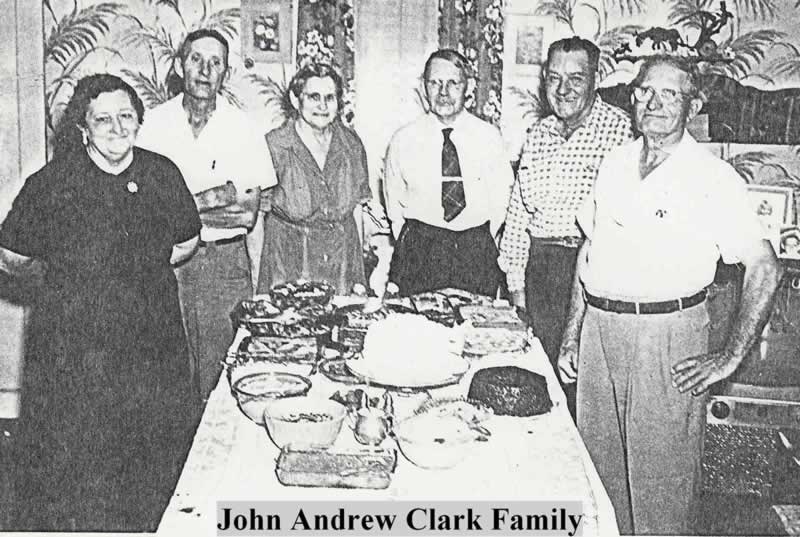|
Moderated by NW Okie! |
Volume 6 , Issue 72004Weekly eZine: (374 subscribers)Subscribe | Unsubscribe Using Desktop... |
John Andrew Clark's Family History...

It was written by William Greenville Clark (son of John Andrew & Martha Susanna Williams Clark). It mentions, "John Andrew Clark, son of Alexander James Clark and Polly Snedegar Clark, was married to Martha Susanna Williams, daughter of John M. Williams and Sarah Williams, on April 29, 1874, in Greenbrier County, West Virginia. To them were born the following children in Greenbrier County West Virginia: William Greenville Clark, born August 18, 1875; Ledona Prudence Clark born April 11, 1877;
Joseph Lawrence Clark born July 29, 1879; Mary May Clark born May 26, 1884....."
John Andrew Clark came to Barber County, Kansas in 1885, worked at whatever he could find to do around Hazelton and Kiowa, Kansas. He was anxiously awaiting the arrival of his wife and family. The two older children, William and Ledona came with their uncle (Robert Williams) in March 1887. Martha Susanna (his wife), Joseph Lawrence and Mary May came in June 1887.
They all lived in Uncle Robert William's small house until the fall of 1888. Harrison and Morton, the twins were born on October 9, 1888 at their Uncle Robert's farm near Hazelton, Kansas. They later moved to Kiowa, Kansas where John Andrew Clark worked on the Santa Fe Section. He sent the older children to school. Another son was born on January 3, 1891, and they named him Ira Clark.
Times were very close at this time... John Andrew found it difficult to feed and clothe the family on the meager wages he received. The section work paid $1.10 per day. The children were too small to be of much help financially. One of the older siblings (Ledona a.k.a. Dona) got a job with a man and his wife and daughter at $1.00 per week, which seemed to be about the prevailing wage at that time. They also had a couple of milk cows which helped out... giving milk for their mush and apple dumplings which one of these items was usually on their menu every day.
During the summer months the Clarks grew vegetables, disposing of the surplus to their neighbors in town. Lawrence and William hauled the produce around town in a little wagon and also took the milk cows out from town...
herding them all day. They received about $1.00 per head a month. That made enough money that they could buy their clothes with a little left
over. They usually pastured the cows in the Cherokee Strip before it was opened for settlement on September 16, 1893 (the Strip laid one mile South of Kiowa).
Shortly before the opening of the Strip for settlement the soldiers came and ordered them to keep their cows out of the Strip. This was followed within a few days by a bunch of Indians. The Run of '93 was something that will never be forgotten by William G. Clark. The Run was to be started at 12 noon on September 16, by the firing of a gun to start the men and women on their race for a home in the Strip. A few minutes before the Run was to start, someone fired a gun by mistake (or on purpose)
and the Run was on. People were along the line for miles in every conceivable conveyance that could be thought of -- Horseback (some with race horses), buggies, wagons and carts and some few just walked across the line and staked a claim.
John A. Clark and his son (William) were on their horses, ready to go at the crack of the gun. They started just west of the Santa Fe railroad on the line one mile South of Kiowa. The Santa Fe train was also on the line with several coach loads of people that were to get off the train as it proceeded slowly along the railway to Alva, Oklahoma (the county seat of Woods County). The race to Alva was for town lots which some of the people wanted instead of a farm. John A. Clark staked a claim about 4 or 5 miles southwest of Kiowa. His son, William, rode back to Kiowa to have the folks bring the wagon with some bedding and grub so they could
stay there for awhile. A few days afterwards John Andrew saw another stake not too far from where he had stuck his stake. He was afraid it was on the same claim he had staked. Rather than face a contest he gave it up. He and Albert Williams went down by Alva and filed on a claim about 4 ½ miles northeast of Alva which was to be their home from then on. In the fall of 1893, John Andrew came down from Kiowa and dug a hole in a bank on the farm and covered it with Sod. That was to be the place that his sons (Lawrence and William) were to spend the winter with the cattle that their father had accumulated. (When I get the whole Clark Family story transcribed and proofread, I will make it available for your reading and research.)
| View or Add Comments (1 Comments)
| Receive
updates ( subscribers) |
Unsubscribe
| © . Linda Mcgill Wagner - began © 1999 Contact Me | |
